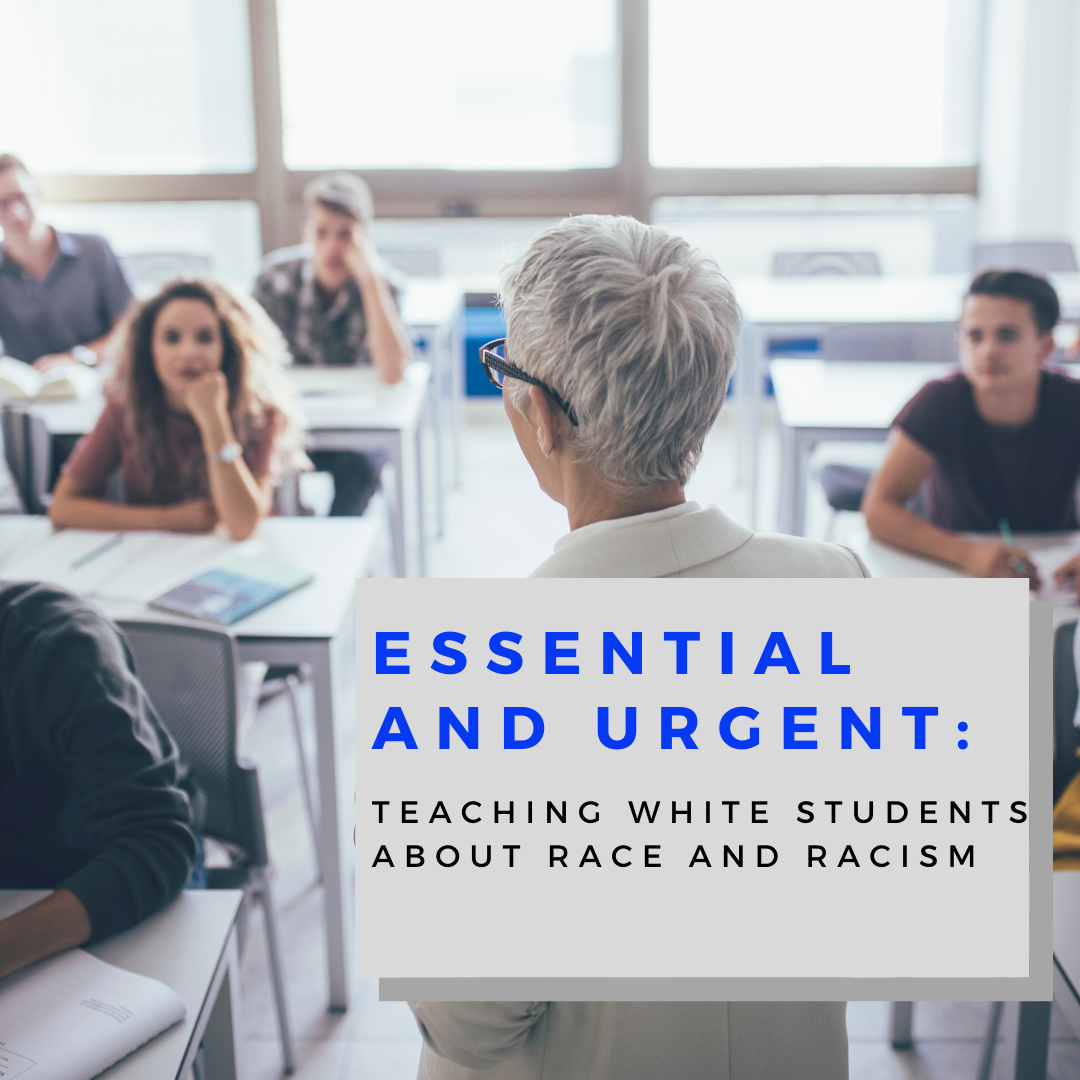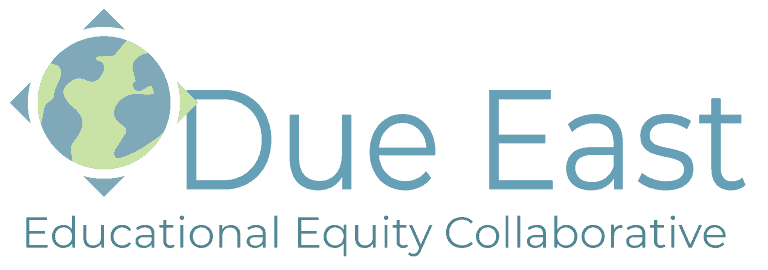Essential and Urgent: Teaching White Students About Race and Racism
So far, I’ve ended the lives of two cars from all the time I’ve spent accumulating miles on Interstate 94 during the course of my life. Many midwesterners won’t be surprised by that–like me, they likely spent a lot of time in a car as a child, when driving at least 30 minutes was the norm just to go get groceries. On those trips, we’d take somewhat-judgemental notes of current road conditions–“I swear the guy the township hired to maintain the roads is drunk half the time”. And then also, occasionally spotting errant livestock. Once, I parked on a neighbor’s very long driveway, took off my belt, and wrapped it around their escaped-the-pasture-again horse’s neck and led it back to the elderly owner’s farmhouse. And many of us have made these trips even longer with our life choices to move away from our small town and rural upbringings into metro areas of various states in order to have a more financially sustainable lifestyle. Most of the people who have these common experiences are also, like me, white. And like me, they probably had a steep learning curve about what it actually means to be white in these United States, an uncomfortable curve that could have been eased had we experienced a culturally competent and equity-minded education from a young age.
Most of the time when we hear talk of equity and cultural competency, it arrives in terms of how we are not serving Black and Brown (BIPOC) students and how their teachers do not share their experiences or culture. Both of those things are true; however, we often omit that white students and teachers who aren’t expected and allowed to develop their equity mindsets are also at a disadvantage. And I don’t mean white students being left behind academically (we KNOW that’s not true in this public education system), but rather, why aren’t we doing more heavy lifting to insure that the equity mindsets that white children are born with are amplified and fostered, even if they attend mostly-white schools?
Young people are born with an inherent curiosity about difference and are especially curious about groups of people who are different from them in all kinds of ways, including race. I believe this can also be understood as everyone being born with an equity mindset of sorts–but our educational systems and upbringings shut down this inherent urge to ask questions and learn about the other in multiple ways. This squelching of equity and cultural competency in education disadvantages white students tremendously, especially when a community is resistant to anti-racist work.
Culturally competent curriculum and instruction is essential for white students to achieve and succeed to their fullest, no matter what counter pressures the community puts on schools. There, I said it. Here I provide some ways to start thinking and acting to help white students accelerate their understanding of how to be a global citizen through growing their already-existing equity lens in our schools, whether rural, urban, or somewhere in between.
*NOTE* As a white female teacher who has had educational experiences in all kinds of schools, and who has resided in both rural and urban communities, please know I acknowledge the existence and very real challenge of community resistance to cultural competency and equity mindset efforts. That resistance takes all kinds of forms, including budgetary (“We can’t afford new materials”), relational (“I don’t want that father to send me another nasty email”), collegial (“I don’t trust my principal–he could easily throw me under the bus and I won’t have a job”) and personal (“Please don’t let me feel stupid in front of my students. I hate making mistakes!”). I have attempted here to share ideas and strategies that can be “dialed” up or down as you are able. If you are doing things that are making you a bit uncomfortable, that is good and definitely what you should aim for. Does it mean you are teaching the entire 1619 Project? Likely not a good starting place if you are in a resistant community. Does it mean you do nothing at all? Nope, that’s not the answer, either. This is delicate work, but our students warrant taking calculated risks.
I’m Still Awkward in My Anti-Racism, but I’m Getting Better!
As a white woman who is also a teacher, my continued self-work in anti-racism is essential to providing a more equitable experience for my students, especially white students. Again, this may seem counterintuitive–don’t we work towards racial equity in order to provide the same opportunities to global majority students as we do white students? Well, yes…but also…
In working with white students for nearly twenty years, I’ve consistently found the biggest hurdle for them to cross is the same as that of adults who are also working on growing their cultural competency– being paralyzed by guilt and shame. Honestly, this is something that bogs down the most well-intentioned white educators, too. Clearly, I don’t have all of the answers on how to help white people move through these huge roadblocks, but I might have one: VULNERABILITY. I’m an open book in my journey, and there’s a lot of bad stories in there. Like when I went to my first conference on whiteness in Iowa and actually asked a Black woman if I could touch her hair. Yep, I did that. It was stupid and terrible. Oh, and that time I didn’t believe a Black student actually wrote that paper, because it was so good. Yeah. I did that. Probably more than once. Those times elders in my life used the n-word and I didn’t challenge them? I did that, too. Not bringing up current politics in order to maintain family peace? You know it. I did that.
It doesn’t feel good to be vulnerable, but it is even worse to stay silent. We owe it to our white students to model the journey of anti-racism, and how it is continual and how we will get better at it. Exposing ourselves to judgement is necessary for growth, and a portal to being a better global citizen. And when we do, we won’t make those same mistakes we made before. We’ll make new mistakes, which is probably best saved for another blog.
Purposeful Representation Matters!
We educators spend a lot of time developing curriculum, and if we don’t, it’s usually because we’re handed a sterile binder with software and expected to follow it. But guess what? Even small and subtle changes can help foster an equitable mindset for our white students. Whenever I add images, music, or expert voices to a lesson, I always prioritize using materials created and shared by BIPOC, regardless of subject matter. If we’re studying algebraic concepts, we’re also going to examine the very roots of the word and why no subject is race-neutral, not even math. I want my students to have a constant wave of difference wash over them, to be constantly surrounded by the work of BIPOC individuals who are often left behind or left out in the whiteness of McGraw-Hill. I want my white students to see and understand that the voices that shape the beauty of the world often don’t sound like theirs, and rather than something to be feared, those voices are ones to be excited about and to amplify.
Useful Tools are Available!
Systems really prioritize employing rubrics and standards to assess achievement. And I get it–we need to be organized and to find ways to measure our growth, as well as discerning needs, priorities, and areas for improvement. I’ve found two things really helpful:
First, implement “ways of being” into the curriculum, regardless of grade level or subject matter. I’ve taught these basic concepts surrounding how individuals, families, and cultures differ in their understanding and preferences in the following categories: idea exchange rates, task/relationship focus, clock time/cyclical time, restrained/expressive emotion, direct/indirect communication, individualism, collectivism, and internal/external locus of control. This long list of concepts new to many educators and students can seem overwhelming, but few concepts of cultural competency have been so easy, so relatable, and so readily accepted by my students and families as these “ways of being.” Just a few minutes over the course of several days can engage students and help them to understand that we have different ways of experiencing the world which are influenced by our cultural upbringings. In addition to learning more about other ways to exist, white students will also be able to identify themselves and their own culture, which in itself is a huge win! When white students are able to identify that they do, in fact, have a culture, it is easier for them to see the power and influence that dominant culture has within society. In addition, they will also be able to recognize how their own ways of being directly shape and inform their successes (and failures) in school.
Second, utilizing the Equity Analysis Template in reframing lessons and units is extraordinarily helpful. This tool contains questions about how to not only re-frame curriculum, but also circles back to the ways of being in terms of how to honor student experience in how they learn, not just what they learn. As educators, we often view the standards and curriculum as goals in themselves…but how we get there is often where the most successful cultural competency lies. How do we design activities? What about collaboration and student choice? Are we co-constructing knowledge with our students? These are all equity-minded aspects of learning–the best practices are the culturally competent ones. Again, when we speak of racial equity in school we primarily focus on Black, Brown and Indigenous students, and that is essential. However, we must also be critical of how standardized and normalized methods of instruction harm white students, who already are often discouraged from growing their own equity mindset. For instance, the following questions from the template give me pause and help me to reframe equitable approaches for white students:
- How does this standard affirm that multiple cultures, histories, and perspectives are important for a comprehensive education? What perspectives are absent?
- What opportunities do students have for self-reflection/evaluation?
I’m from the land of Interstates 94, I-29, and let’s not forget Highway 10. I wish I’d had even one teacher in my formative years who had believed representation mattered. I wish I’d had even one teacher who took the time and care to teach me there are many ways of being. I wish I’d had even one white teacher who had shown me that being anti-racist matters even though I was surrounded only by students who were white, like me. If only one teacher had modeled that I’d make mistakes when working on my cultural competency, but those mistakes would become fewer with continual practice. If only….because if I‘d had those teachers, I would be light years ahead of where I am now in being not just a better teacher, but a better white woman. So let’s do it now, so our white students don’t have to wait as long to get what they need.


